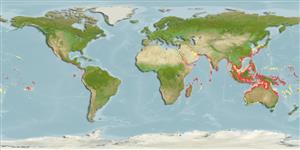>
Tetraodontiformes (Puffers and filefishes) >
Tetraodontidae (Puffers) > Tetraodontinae
Etymology: Takifugu: A Japanese word with several meanings; taki = waterfall + fugu = fish; it could be also understood as taki = to be cooked in liquid + fugu = a venomous fish.
More on author: Bloch.
Environment: milieu / climate zone / depth range / distribution range
Ecología
marino; salobre demersal. Tropical
Indo-West Pacific: South Africa to Indonesia, north to Japan, south to Australia.
Tamaño / Peso / Age
Maturity: Lm ? range ? - ? cm
Max length : 40.0 cm TL macho / no sexado; (Ref. 4919)
Short description
Claves de identificación | Morfología | Morfometría
Espinas dorsales (total) : 0; Radios blandos dorsales (total) : 12 - 14; Espinas anales: 0; Radios blandos anales: 10 - 12. Body covered with prickles (Ref. 559). Brownish above with pale spots, yellowish white below; narrow dark bars on sides (Ref. 4919).
Lives in shallow coastal waters, but enters brackish waters (Ref. 4833).
Life cycle and mating behavior
Madurez | Reproducción | Puesta | Huevos | Fecundidad | Larva
Masuda, H., K. Amaoka, C. Araga, T. Uyeno and T. Yoshino, 1984. The fishes of the Japanese Archipelago. Vol. 1. Tokai University Press, Tokyo, Japan. 437 p. (text). (Ref. 559)
IUCN Red List Status (Ref. 130435: Version 2024-1)
Threat to humans
Harmless
Human uses
Pesquerías: de interés potencial
Herramientas
Special reports
Download XML
Fuentes de Internet
Estimates based on models
Preferred temperature (Ref.
123201): 24.1 - 29.1, mean 28.2 °C (based on 1410 cells).
Phylogenetic diversity index (Ref.
82804): PD
50 = 0.5000 [Uniqueness, from 0.5 = low to 2.0 = high].
Bayesian length-weight: a=0.01995 (0.01156 - 0.03445), b=2.90 (2.76 - 3.04), in cm total length, based on LWR estimates for this species & Genus-body shape (Ref.
93245).
Nivel trófico (Ref.
69278): 3.2 ±0.44 se; based on food items.
Resiliencia (Ref.
120179): Medio, población duplicada en un tiempo mínimo de 1.4-4.4 años (Preliminary K or Fecundity.).
Fishing Vulnerability (Ref.
59153): Low to moderate vulnerability (30 of 100).
